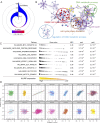Holliday junction recognition protein (HJURP) could reflect the clinical outcomes of lung adenocarcinoma patients, and impact the choice of precision therapy
- PMID: 39649097
- PMCID: PMC11621083
- DOI: 10.3389/fgene.2024.1475511
Holliday junction recognition protein (HJURP) could reflect the clinical outcomes of lung adenocarcinoma patients, and impact the choice of precision therapy
Abstract
Background: Lung adenocarcinoma (LUAD) is the most prevalent subtype of non-small cell lung cancer (NSCLC), characterized by poor prognosis and a high mortality rate. Identifying reliable prognostic biomarkers and potential therapeutic targets is crucial for improving patient outcomes.
Methods: We conducted a comprehensive analysis of HJURP expression in LUAD using data from four cohorts: TCGA-LUAD (n = 453), GSE31210 (n = 226), GSE68465 (n = 442), and GSE72094 (n = 386). Univariate Cox regression analysis was employed to identify prognostic genes, with Kaplan-Meier survival analysis used to assess the predictive power of HJURP. Functional enrichment analyses were performed using MetaScape and FGSEA, and spatial transcriptomics and single-cell sequencing data were analyzed to explore HJURP's distribution and potential functions. Additionally, correlations between HJURP expression and genetic alterations, immune cell infiltration, and potential therapeutic responses were evaluated.
Results: HJURP was identified as a significant prognostic biomarker in all four cohorts, with high expression associated with increased risk of overall survival (OS) death (TCGA-LUAD: HR = 1.93, 95% CI: 1.321-2.815, P < 0.001; GSE31210: HR = 2.75, 95% CI: 1.319-5.735, P = 0.007; GSE68465: HR = 1.57, 95% CI: 1.215-2.038, P < 0.001; GSE72094: HR = 2.2, 95% CI: 1.485-3.27, P < 0.001). Functional analyses indicated that HJURP is involved in DNA metabolic processes, cell cycle regulation, and mitotic processes, with significant activation of pathways related to MYC targets, G2M checkpoint, and DNA repair. High HJURP expression was associated with higher mutation frequencies in TP53, CSMD3, TTN, and MUC16, and positively correlated with pro-inflammatory immune cell infiltration and several immune checkpoints, including PD-L1 and PD-L2. Chemotherapeutic agents such as gefitinib and sorafenib were predicted to be effective against high HJURP-expressing tumors.
Conclusion: HJURP is a pivotal biomarker for LUAD, consistently associated with poor prognosis and advanced disease stages. Its high expression correlates with specific genetic alterations and immune profiles, highlighting its potential as a therapeutic target. Future studies should validate these findings in larger cohorts.
Keywords: HJURP; genetic alterations; immune infiltration; lung adenocarcinoma; prognosis.
Copyright © 2024 Gao, Zhang, Zhang and Sun.
Conflict of interest statement
The authors declare that the research was conducted in the absence of any commercial or financial relationships that could be construed as a potential conflict of interest.
Figures








Similar articles
-
Prognostic value of Holliday junction-recognizing protein and its correlation with immune infiltrates in lung adenocarcinoma.Oncol Lett. 2022 May 27;24(1):232. doi: 10.3892/ol.2022.13353. eCollection 2022 Jul. Oncol Lett. 2022. PMID: 35720487 Free PMC article.
-
Comprehensive analysis identifies DNA damage repair-related gene HCLS1 associated with good prognosis in lung adenocarcinoma.Transl Cancer Res. 2023 Oct 31;12(10):2613-2628. doi: 10.21037/tcr-23-921. Epub 2023 Oct 24. Transl Cancer Res. 2023. PMID: 37969376 Free PMC article.
-
Leveraging diverse cell-death patterns to predict the clinical outcome of immune checkpoint therapy in lung adenocarcinoma: Based on muti-omics analysis and vitro assay.Oncol Res. 2023 Dec 28;32(2):393-407. doi: 10.32604/or.2023.031134. eCollection 2023. Oncol Res. 2023. PMID: 38186574 Free PMC article.
-
Development and validation of a robust immune-related prognostic signature in early-stage lung adenocarcinoma.J Transl Med. 2020 Oct 7;18(1):380. doi: 10.1186/s12967-020-02545-z. J Transl Med. 2020. PMID: 33028329 Free PMC article.
-
Identification of CDT1 as a prognostic marker in human lung adenocarcinoma using bioinformatics approaches.PeerJ. 2023 Sep 28;11:e16166. doi: 10.7717/peerj.16166. eCollection 2023. PeerJ. 2023. PMID: 37790630 Free PMC article.
References
LinkOut - more resources
Full Text Sources
Research Materials
Miscellaneous

